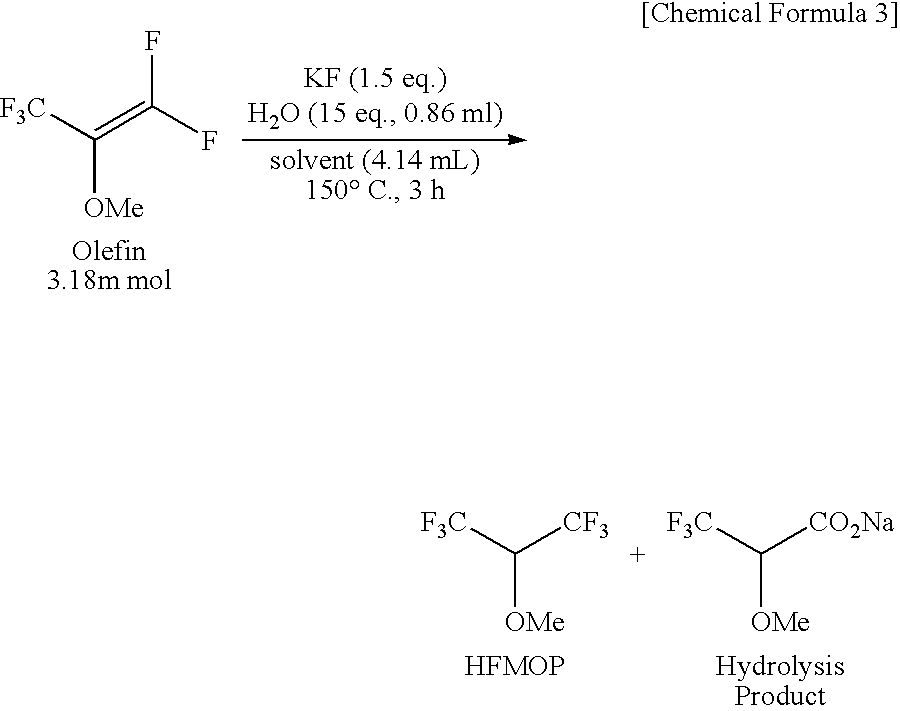Novel carboxylic acid compound, use thereof, and process for producing the same
a carboxylic acid and compound technology, applied in the field of new carboxylic acid, can solve the problems of low cost of sevoflurane, unsuitable for mass production, industrial scale implementation, etc., and achieve the effects of low cost, high yield and efficient production
- Summary
- Abstract
- Description
- Claims
- Application Information
AI Technical Summary
Benefits of technology
Problems solved by technology
Method used
Image
Examples
example 1
[0075](i) A 1 L four-necked flask equipped with a dropping funnel, a thermometer, and a stirrer was charged with 300 g (1.33 mol) of (CF3)2C(OH)CO2CH3 and 300 g of acetone, and 183 g (1.33 mol) of K2CO3 was added thereto while stirring the mixture in an ice bath. The ice bath was replaced with a water bath, and 176 g (1.39 mol) of (CH3O)2SO2 was added dropwise in such a manner that the internal temperature was 30° C. or less. After an hour of stirring, the dropping funnel was replaced with a condenser tube, and the temperature was elevated to the reflux temperature to allow the reaction to proceed for 3 hours. Gas chromatographic analysis of the reaction product confirmed that (CF3)2C(OH)CO2CH3 had been completely consumed. H2O was added, and the lower layer, i.e., the organic layer, was separated through a separating funnel, and then the organic layer was washed twice with H2O. The resulting organic layer was distilled under reduced pressure (150 mmHg, 86-88° C.) to produce 247 g (...
example 2
[0077]A 100 mL four-necked flask equipped with a dropping funnel, a thermometer, and a stirrer was charged with 10 g (41.7 mmol) of (CF3)2C(OCH3)CO2CH3 obtained in Step (i) of Example 1, and 11.7 g (41.7 mmol) of 20 wt % KOH was added dropwise while stirring in a water bath. After the dropwise addition was completed, the reaction was allowed to proceed for 18 hours in the water bath. 19F NMR analysis of the reaction product confirmed that (CF3)2C(OCH3)CO2CH3 had been completely consumed. The resulting reaction solution was evaporated to give 11.0 g of (CF3)2C(OCH3)CO2K as a white solid. The spectral data of the resulting compound are as follows: 19F-NMR: −70.64 ppm (CF3)
example 3
[0078]A 100 mL four-necked flask equipped with a dropping funnel, a thermometer, and a stirrer was charged with 51.3 g (0.227 mol) of (CF3)2C(OH)CO2CH3, and 50 ml of water and 50 ml of ethanol were added, after which 51 g (0.227 mol) of 25% aqueous KOH solution was slowly added dropwise while heating and stirring the mixture in a warm bath at 40° C. The water layer was separated and concentrated with an evaporator to remove the methanol, to produce 79 g of aqueous (CF3)2C(OH)CO2K solution.
[0079]Ten grams (0.029 mol) of the thus obtained aqueous potassium salt solution and 9.0 g (0.04 mol) of 25% aqueous KOH solution were added to a 100 ml four-necked flask, and then 5.0 g (0.04 mol) of dimethyl sulfate was slowly added dropwise at an internal temperature of 45° C. or less, while cooling with water and stirring. After the dropwise addition was completed, and after confirming that the internal temperature had stopped increasing, the mixture was heated in a warm bath and then heated an...
PUM
| Property | Measurement | Unit |
|---|---|---|
| chemical | aaaaa | aaaaa |
| temperature | aaaaa | aaaaa |
Abstract
Description
Claims
Application Information
 Login to View More
Login to View More - R&D
- Intellectual Property
- Life Sciences
- Materials
- Tech Scout
- Unparalleled Data Quality
- Higher Quality Content
- 60% Fewer Hallucinations
Browse by: Latest US Patents, China's latest patents, Technical Efficacy Thesaurus, Application Domain, Technology Topic, Popular Technical Reports.
© 2025 PatSnap. All rights reserved.Legal|Privacy policy|Modern Slavery Act Transparency Statement|Sitemap|About US| Contact US: help@patsnap.com



